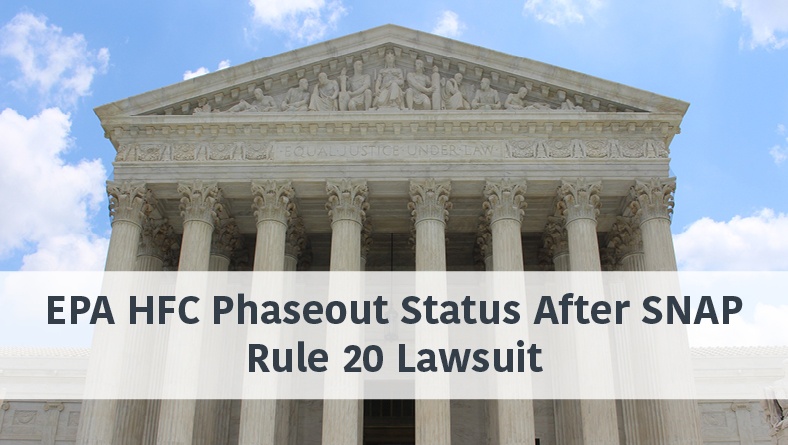
Trakref
EPA SNAP Rule 20 Lawsuit HFC Phaseout Status

Let’s do a quick rundown on the United States EPA SNAP Rule 20 lawsuit, which basically threw a wrench into the EPA HFC phaseout. 🔧 This will effect compliance in refrigerant tracking as well as environmental sustainability and corporate sustainability initiatives to decrease our environmental footprint.
EPA SNAP Rule 20 Lawsuit HFC Phaseout
So you’re probably wondering: Why is everyone still talking about this lawsuit?
Well, to put it in simplest terms, this lawsuit basically threw a wrench🔧 into the EPA HFC phaseout, making it subject to admiralty process.
It’s been a confusing 😕 mess of events with question of law ever since the Mexichem Fluor, Inc., v. EPA decision last August.
We’re going to break it all down for you now to (hopefully) clear up any of your confusion so we can all join in one action to fight climate change. 🌥️ ➡️ ☀️
EPA SNAP Rule 20 Explained
Under the final rule of SNAP Rule 20, various HFCs and HFC-containing blends that were previously listed as acceptable ✅ were listed as unacceptable ❌ in various end-uses in the aerosols, foam blowing, and refrigeration and air conditioning sectors, forcing HVAC/R professionals to find an acceptable substitute due to their overall risks to human health and the environment. SNAP Rule 20 looks at environmental and human health as it relates to industrial process refrigeration. It promotes the Clean Air Act (CAA) and the trends in monitoring refrigerants that it started, looking at human health impacts and significant new alternatives.
This post focuses on end-uses in the refrigeration and air conditioning sectors.
Specifically, this rule affected retail food refrigeration end uses 🏪including
- supermarket systems (new and retrofit);
- remote condensing units (new and retrofit);
- and stand-alone retail food refrigeration equipment (new and retrofit).
These are the HFC substitutes it found unacceptable ❌ in retail food refrigeration end uses which persons may join in phasing out:
SNAP Rule 20 and Retail Food Refrigeration End Uses
Supermarket Systems (Retrofit)
HFC Substitutes: R-404A, R-407B, R-421B, R-422A, R-422C, R-422D, R-428A, R-434A, R-507A
Decision: Unacceptable as of July 20, 2016
Supermarket Systems (New)
HFC Substitutes: HFC-227ea, R-404A, R-407B, R-421B, R-422A, R-422C, R-422D, R-428A, R-434A, R-507A
Decision: Unacceptable as of January 1, 2017
Remote Condensing Units (Retrofit)
HFC Substitutes: R-404A, R-407B, R-421B, R-422A, R-422C, R-422D, R- 428A, R-434A, R-507A
Decision: Unacceptable as of July 20, 2016
Remote Condensing Units (New)
HFC Substitutes: HFC-227ea, R-404A, R-407B, R-421B, R-422A, R-422C, R-422D, R-428A, R-434A, R-507A
Decision: Unacceptable as of January 1, 2018
Stand-Alone Units (Retrofit)
HFC Substitutes: R-404A, R-507A
Decision: Unacceptable as of July 20, 2016
Stand-Alone Medium-Temperature Units with a compressor capacity below 2,200 Btu/hour and not containing a flooded evaporator (New)
HFC Substitutes: FOR12A, FOR12B, HFC-134a, HFC-227ea, KDD6, R- 125/290/134a/600a (55.0/1.0/42.5/1.5), R-404A, R- 407A, R-407B, R-407C, R-407F, R-410A, R-410B, R- 417A, R-421A, R-421B, R-422A, R-422B, R-422C, R- 422D, R-424A, R-426A, R-428A, R-434A, R-437A, R- 438A, R-507A, RS-24 (2002 formulation), RS-44 (2003 formulation), SP34E, THR-03
Decision: Unacceptable as of January 1, 2019
Stand-Alone Medium-Temperature Units with a compressor capacity equal to or greater than 2,200 Btu/hour and Stand-Alone Medium-Temperature Units containing a flooded evaporator (New)
HFC Substitutes: FOR12A, FOR12B, HFC-134a, HFC-227ea, KDD6, R-
125/290/134a/600a (55.0/1.0/42.5/1.5), R-404A, R- 407A, R-407B, R-407C, R-407F, R-410A, R-410B, R- 417A, R-421A, R-421B, R-422A, R-422B, R-422C, R- 422D, R-424A, R-426A, R-428A, R-434A, R-437A, R- 438A, R-507A, RS-24 (2002 formulation), RS-44 (2003 formulation), SP34E, THR-03.
Decision: Unacceptable as of January 1, 2020
Stand-Alone Low-Temperature Units (New)
HFC Substitutes: HFC-227ea, KDD6, R-125/290/134a/600a (55.0/1.0/42.5/1.5), R-404A, R-407A, R-407B, R-407C, R-407F, R-410A, R-410B, R-417A, R-421A, R-421B, R- 422A, R-422B, R-422C, R-422D, R-424A, R-428A, R- 434A, R-437A, R-438A, R-507A, RS-44 (2003 formulation)
Decision: Unacceptable as of January 1, 2020
In essence, this is what the question of law called for when it came to stationary HVAC/R applications.
Please note: The information you see above is historical information only.
It is what SNAP Rule 20 called for prior to the court decision.
Indeed after the court case, with relief demanded and a series of transactions, these decisions of unacceptability have been dismissed. ‼️
So, now, these HFCs are allowed ✅ in law or fact common, and arise in the action with property subject to admiralty, which leads us to our next point:
Why were the HFC unacceptable listings dismissed in SNAP Rule 20?
On Aug. 8, 2017, the Mexichem Fluor, Inc., v. EPA decision dismissed the part of the rule that banned HFCs in the various end uses with action as defendants. (This has become known as the SNAP Rule 20 lawsuit.)
In a transaction of occurrences, the case ruled that the EPA did not possess authority under Section 612(c) to require the replacement of non-ozone-depleting substances, even with their risks to human health.
It states, “In short, we vacate the 2015 Rule to the extent the Rule requires manufacturers to replace HFCs with a substitute substance.”
So, it’s a partial dismissal (vacatur).
But it doesn’t stop there. In fact, the case also states, “EPA’s reliance on the statutory term ‘replace’ does not justify the 2015 Rule. But that is not necessarily the end of the matter.
EPA suggests that it may be able to require manufacturers to replace HFCs under an alternative theory. The question under that alternative theory is this:
May EPA retroactively conclude that a manufacturer’s past decision to ‘replace’ an ozone-depleting substance with HFCs is no longer lawful, even though the original replacement with HFCs was lawful at the time it was made?”
Importantly, it concludes: “We may not uphold the Rule based on the ‘retroactive disapproval’ theory … Rather, we must remand to EPA.”
It then explains that the EPA would have to address at least three issues if it “decides to pursue this ‘retroactive disapproval’ approach.”
What is that status of the EPA HFC Phaseout After the SNAP Rule 20 Lawsuit?
After this court decision, the EPA HFC phaseout is muddy.
It’s important to note that SNAP Rule 20 is not the only SNAP regulation that listed HFCs as unacceptable.
We must not overlook SNAP Rule 21, which also listed certain HFC substitutes as unacceptable in cold storage warehouse (new), retail food refrigeration – refrigerated food processing and dispensing equipment (new), and household refrigerators and freezers (new).
This other SNAP Rule complicates this entire discussion on the status of the EPA HFC phaseout.
We’re going to try and keep it as simple as possible for you.
So, here’s what we do know (for now) ⬇️:
1. SNAP Rule 20 has been partially dismissed.
The keyword here is partially, and there is also the fact of the remand. The EPA is preparing to engage in rulemaking to address the court’s remand of the Rule.
2. SNAP Rule 21 is still in effect but under litigation.
While the SNAP Rule 20 lawsuit has been continuously talked about, SNAP Rule 21 (another EPA regulation on HFC prohibitions) has not been talked about much. It’s still in effect but under litigation.
3. The EPA HFC phaseout is very much up in the air at this point.
Yes, at the federal level, the EPA HFC phaseout is very much up in the air.
However, this does not mean that you should just throw all your cares to the wind when it comes to using high-GWP HFC refrigerants. Many states, including California, Connecticut, Maryland, and New York, have signaled that they may be introducing their own HFC initiatives.
Well, that concludes our post on the EPA HFC phaseout status after the SNAP Rule 20 lawsuit.
Are you having trouble keeping up with all the activity around the HFC court decision on SNAP Rule 20?
If you’re looking for a partner in refrigerant compliance, turn to Trakref. We’re a software corporation that has been in the regulatory compliance software and environmental compliance calendar software space for years. As an environmental software provider, we make sure our refrigerant capabilities will help you in your journey towards compliance, as well as helping you with ESG reporting and answering sustainability audit questions.
As always, thanks for joining. Please note: This is not legal advice.



